Southern (Govia Thameslink Railway)
 | |||
 A pair of Southern Class 377s at London Victoria Platforms 18 and 19 awaiting departure to Eastbourne and Reigate | |||
| Overview | |||
|---|---|---|---|
| Franchise(s) |
| ||
| Main Region(s) | Greater London, South East England | ||
| Other Region(s) | East of England | ||
| Fleet size | |||
| Stations called at | 213 | ||
| Stations operated | 156 | ||
| Parent company | Govia Thameslink Railway | ||
| Reporting mark | SN | ||
| Technical | |||
| Track gauge | 1,435 mm (4 ft 8+1⁄2 in) standard gauge | ||
| Electrification | 750 V DC third rail 25 kV 50 Hz AC OHLE | ||
| Length | 666.3 km (414.0 mi)[citation needed] | ||
| Other | |||
| Website | www | ||
| |||

Southern is the brand name used by the Govia Thameslink Railway (GTR) train operating company on the Southern routes of the Thameslink, Southern and Great Northern franchise in England.[2] It is a subsidiary of Govia, a joint venture between transport groups Go-Ahead and Keolis, and has operated the South Central franchise since August 2001 and the Gatwick Express service since June 2008. When the passenger rail franchise was subsumed into GTR, Southern was split from Gatwick Express and the two became separate brands, alongside the Thameslink and Great Northern brands.
Southern operates the majority of commuter services from its Central London terminals at London Bridge and London Victoria to South London, East and West Sussex, as well as regional services in parts of Hampshire, Kent and Surrey. It also provides services between Watford Junction and Croydon via the West London line.
For three consecutive years from 2016 to 2018, Southern came last on passenger satisfaction in surveys conducted by the consumer group Which?, scoring low for value for money, reliability, and punctuality in 2018.[3] In 2022, Southern was ranked second-worst on overall passenger satisfaction in a survey conducted by Transport Focus.[4]
History
[edit]As part of the wider privatisation of the state owned railway operator British Rail in the 1990s, Connex South Central was awarded the Network SouthCentral franchise by the Director of Passenger Rail Franchising. Operations commenced on 26 May 1996.
In March 2000, the Shadow Strategic Rail Authority (SSRA) announced its intention to relet the franchise from May 2003; both Connex and Govia were shortlisted.[5][6] In October 2000, the SSRA announced that Govia had been awarded the franchise and would operate it from May 2003.[7] Govia negotiated a deal with Connex to buy out the remainder of its franchise, this was completed in August 2001.[8][9][10] Govia trading as SouthCentral[11] took over operations on 26 August 2001. The franchise was originally to run for twenty years but, in 2002, the Strategic Rail Authority changed the way it handled financing agreements and therefore Govia was re-awarded with a seven-and-a-half-year franchise until December 2009.[7][12][13]
In May 2003, the franchise was rebranded as Southern in a recall of the pre-nationalisation Southern Railway, using a green roundel logo with Southern in yellow in a green bar.
During April 2007, the Department for Transport (DfT) announced that the Gatwick Express franchise was to be incorporated into the main South Central franchise.[14][15] This reorganisation was part of a wider plan to increase capacity on the Brighton Main Line, involving the extension of peak-hour services from Gatwick to Brighton and Eastbourne from December 2008. This change doubled the number of London to Brighton express trains during those periods.[16]
In December 2008, Southern took over the services on the Redhill to Tonbridge Line from Southeastern.[17]
The South Central franchise end date was brought forward to September 2009 upon the integration of the Gatwick Express service, to allow the new operator to be in place during major changes to the timetable in and around South London in December 2009.[18] In the run-up to the bidding process for the franchise, reports emerged suggesting that Transport for London, the operator of the London Overground service, wished to take control of all overground services in South London, including the 'Metro' area of the South Central franchise.[19][20] However, such a transfer never took place and the DfT put out the entire franchise for tender.
In August 2008, the DfT shortlisted Govia, National Express, NedRail and Stagecoach for the new South Central franchise.[21][22][23] In June 2009, the DfT announced that Govia had retained the franchise, to start on 20 September 2009.[24][25]
In March 2012, the Department for Transport announced that Abellio, FirstGroup, Govia, MTR and Stagecoach had been shortlisted for the new Thameslink, Southern and Great Northern franchise.[26][27] The Invitation to Tender was to be issued in October 2012, with the successful bidder announced in spring 2013. However, in the wake of the collapse of the InterCity West Coast refranchising process, the government announced in October 2012 that the process would be put on hold pending the results of a review.[28]
In December 2012, Southern's London Victoria to London Bridge via Denmark Hill service ceased, being partially replaced by London Overground's new Clapham Junction to Dalston Junction service.
At the conclusion of the Southern franchise in July 2015, the South Central franchise was merged into the Govia Thameslink Railway franchise, which is run as a management contract rather than a traditional franchise.[29][30] However, the Southern brand was retained.[31]
2007 and 2008 timetables
[edit]Southern was criticised for major changes to its timetables in December 2007 and December 2008.
In December 2007, Southern changed the arrangement for the splitting of services to and from London Victoria on the Arun Valley Line, opting to split trains at Horsham rather than Barnham, as well as run the portion to Portsmouth or Southampton non-stop to Barnham. Some passengers criticised this change as it increased the journey time to and from London by up to 10 minutes from certain stations, while in the event of services running behind schedule, trains were sometimes not split at Horsham, and proceeded non-stop to Barnham, leaving Arun Valley commuters at Horsham with the prospect of no onward trains.[32]
During December 2008, further timetable changes included the introduction of the extended Gatwick Express services. However, reliability and timekeeping on some of the new services were considered poor, leading to several public meetings being held.[33][34][35] On 22 January 2009, Southern responded to some of these criticisms. During 2009, these services have recorded improved timekeeping and criticisms have since subsided.[36]
The new timetable also led to unhappiness due to the difference in speed and frequency of service between East Coastway services and those on the Brighton Main Line.[37][38]
December 2010 timetable
[edit]Further changes to the timetable were made in December 2010; the first timetable change to include many of the requirements of the new franchise. Additional services were included at evenings and weekends. In the London area a 'metro' frequency of service was introduced on most routes with the extension of the weekday daytime four-trains-per-hour norm to late evenings (up to around midnight), Saturdays and Sundays. In addition, new late-night services were introduced from London on Friday and Saturday nights with last trains leaving central London at around 00:30.[39]
Outside London, a new later-evening service was introduced to Uckfield from London Bridge, new late-night services from Brighton along the West Coastway line and direct services between Southampton and Brighton on Sundays.[39]
Punctuality and overcrowding
[edit]In January 2015, Southern hit controversy when it was revealed that the 7.29am Brighton to London Victoria train failed to get in on time on any occasion out of all 240 attempts in 2014.[40] Later in May 2015 it was revealed that Southern had fined passengers for standing in first class on an overcrowded train.[41] Only 20% of Southern trains arrived on time in the year from April 2015 to March 2016, and there was an ongoing industrial dispute over driver-only operated trains.[42][43] In late 2016, the Transport Select Committee told ministers to "get a grip" on railway franchises, with their report asking if the train operator was in breach of their contractual obligations due to the large number of cancelled trains, and went on to say, "in normal circumstances, this would be grounds for termination of the contract".[44][45]
2016 amended timetable
[edit]In 2016, the company introduced an "amended timetable [that] would be a temporary measure until staffing returned to normal" to be announced on 5 July. The National Union of Rail, Maritime and Transport Workers (RMT) trade union said that 350 services would be cancelled every day (the company ran 2,242 weekday services in the previous timetable). The company said it had insufficient personnel, and too many were taking sick leave; the union denied that high levels of sickness were the cause of cancellations, while agreeing that there were an insufficient number of guards and drivers.[46]
The government Department for Transport said that the situation was unacceptable. While the company was obliged to notify the department in advance, this did not amount to giving the company permission for the changes. The RMT union general secretary Mick Cash said the government had permitted GTR to introduce the emergency timetable, but that it was "nothing to do with staff sickness and everything to do with gross mismanagement of this franchise and the failure to employ enough guards and drivers. ... a cynical and cowardly ploy".[46]
The London Evening Standard mentioned Southern in an article in June 2016 "Southern rail suggests commuter goes on 100 mile detour to Clapham instead of her normal six minute journey".[47] In June 2016, amongst criticism of the performance of its services, Go-Ahead warned of lower than anticipated profits on its Govia Thameslink Railway franchises, leading to an 18% drop in the Go-Ahead share price.[48]
From 31 October 2016, Southern restored the full weekday timetable.[49]
Control of doors and strikes
[edit]In 2016, Southern altered its method of door operation, with control of the doors moving from the conductor to the driver. Southern said this would allow the conductor to concentrate on the passengers, but the RMT and Associated Society of Locomotive Engineers and Firemen (ASLEF) unions said that it was an attempt to make conductors unnecessary and would be unsafe. The rail safety regulator, the Rail Standards and Safety Board has said that "We have 30 years of data which we have analysed. We have found that the driver performing the task does not increase the risk to passengers at all."[50] During 2016, the RMT and ASLEF unions went on strike over the changes, causing severe disruption to Southern services.[51] The strikes continued into 2017.[52]
The BBC suggested that the RMT union are particularly worried about the new method of operation because if drivers (rather than conductors) control the doors then trains could run without conductors and thus any strike by conductors would not have the power to cancel trains.[53]
In December 2016, it was announced that the government would pay £50 million to Southern to cover the costs of the disruption caused by the strikes, due to a deal between the government and Southern. This deal means that the government pays £38 million for lost revenue and £15 million in compensation to passengers. This deal also means that Govia Thameslink Railway will save around £1.1 million in pay for striking workers.[54] Commentators argued that the government gave a management contract rather than a normal franchise to GTR in order to push through DOO. The management contract meant that GTR did not have the incentive to resolve strikes as a normal franchisee would have, as the government lost money from strikes rather than GTR.[55][56]
On 2 February 2017, the TUC announced that talks between Southern and ASLEF had reached an agreement meaning that the dispute with ASLEF had been resolved. However, the RMT union said it was 'betrayed' by Southern and that strikes by the RMT would continue.[57] On 29 June 2017, ASLEF implemented an overtime ban with the aim of highlighting a claimed failure by Southern to recruit adequate staff.
Services
[edit]The standard off-peak service as of June 2024 is:[58]
| Brighton Main Line | ||
|---|---|---|
| Route | tph | Calling at |
| London Victoria – Littlehampton | 2 | |
| London Victoria – Eastbourne | 1 |
|
| London Victoria – Ore | 1 |
|
| Arun Valley line | ||
| Route | tph | Calling at |
| London Victoria – Portsmouth Harbour via Crawley | 2 |
|
| London Victoria – Bognor Regis via Crawley | 2 |
|
| Seaford branch line | ||
| Route | tph | Calling at |
| Brighton – Seaford | 2 |
|
| East Coastway and Marshlink lines | ||
| Route | tph | Calling at |
| Brighton – Eastbourne | 1 | |
| Brighton – Ore | 1 |
|
| Eastbourne – Ashford International | 1 |
|
| West Coastway line | ||
| Route | tph | Calling at |
| Brighton – Southampton Central | 2 |
|
| Brighton – Portsmouth & Southsea | 1 |
|
| Brighton to Chichester via Littlehampton | 1 |
|
| Barnham – Bognor Regis | 2 | Shuttle service |
| Oxted line | ||
| Route | tph | Calling at |
| London Victoria – East Grinstead | 1 |
|
| London Bridge – Uckfield | 1 |
|
| Reigate and Redhill–Tonbridge line | ||
| Route | tph | Calling at |
| London Victoria – Reigate | 2 | |
| Redhill – Tonbridge | 1 | |
| West London Route | ||
| Route | tph | Calling at |
| Watford Junction – East Croydon | 1 |
|
| Mole Valley Line | ||
| Route | tph | Calling at |
| London Victoria – Dorking via Carshalton | 1 | |
| London Victoria – Horsham via Carshalton | 1 |
|
| London Victoria – Epsom Downs via Norbury | 2 |
|
| London Bridge – Epsom | 2 |
|
| Caterham and Tattenham Corner lines | ||
| Route | tph | Calling at |
| London Bridge – Caterham | 2 |
|
| London Bridge – Tattenham Corner | 2 |
|
| London via Crystal Palace and/or Tulse Hill | ||
| Route | tph | Calling at |
| London Victoria – West Croydon via Crystal Palace | 2 |
|
| London Victoria – London Bridge via Crystal Palace | 2 |
|
| London Bridge – East Croydon via Tulse Hill | 2 | |
| London Bridge – Beckenham Junction via Tulse Hill and Crystal Palace | 2 |
|

Rolling stock
[edit]As of May 2022[update], Southern services are almost entirely operated by 214 Class 377 electric multiple units, with the exception of services on the unelectrified Marshlink line and the Uckfield branch of the Oxted line, which use Class 171 diesel multiple units.
South Central inherited a fleet of Class 205, Class 207, Class 319, Class 421, Class 423, Class 455 and Class 456 multiple-unit trains from Connex South Central. Southern inherited a Class 73 locomotive and Class 460 Juniper trains from Gatwick Express.[citation needed]
A franchise commitment was to replace all the Mark 1 slam-door stock, resulting in Southern ordering 28 three-car DC, 139 four-car DC and 15 four-car dual-voltage Class 377 Electrostars in September 2001 and March 2002 to replace the Class 421, Class 422 and Class 423s.[59]
In August 2002, Southern ordered nine two-car and six four-car Class 171 Turbostars to replace the Class 205s and Class 207s on the routes that are not fully electrified.[60] A tenth two-car Class 171 was transferred from South West Trains, entering traffic in July 2007.[61][62]
In 2007, Southern ordered 12 four-car, dual-voltage Class 377/5 Electrostars to replace the remaining twelve Class 319s for transfer to First Capital Connect. In March 2008 Go Ahead purchased a further 11 Class 377/5s. All 23 ended up being sublet to First Capital Connect to provide extra stock for the Thameslink Programme Key Output Zero changes from March 2009. However, due to delays in their production, Class 377/2s were also sublet. To cover for this, Class 350/1s were subleased from London Midland.[63]
To provide stock for the extended Gatwick Express services to Brighton, in 2008 Southern leased 17 Class 442 Wessex Electrics withdrawn by South West Trains in early 2007. After retaining the franchise in 2009, Southern leased the remaining seven Class 442s. The last of the Class 460 Junipers were withdrawn in September 2012.[64]
To release Class 377/3s for use on London suburban services, Southern introduced a fleet of ex-London Overground Class 313s on the Coastway lines from May 2010.[65][66][67] The Class 313s remained in service until May 2023, when they were withdrawn and replaced by Class 377s.[68]
During 2011, Southern announced that, because of delays in procuring new trains for the Thameslink Programme, the 23 Class 377/5s on sub-lease to First Capital Connect would not be returned in time to deliver the operator's planned capacity increases from the December 2013 timetable change. It therefore began a process to procure 130 new vehicles.[69] It was announced in December 2011 that Bombardier had been contracted to supply 26 five-car Class 377/6s.[70] In November 2012, it was announced that an option for a further 40 vehicles was being exercised.[71]
All twenty-four Class 456s were transferred to South West Trains in 2014 after the introduction of the Class 377/6 fleet.[citation needed]
In April 2016, Southern commenced a lease for nine three-carriage Class 170s last used by First ScotRail from Eversholt Rail Group. Four (170421–424) moved to Wolverton Works in 2015 and were reconfigured as two two-carriage and two four-carriage Class 171s. The other five (170416–420) remain in Scotland on sub-lease to Abellio ScotRail and were scheduled to move to Southern in 2018.[72][73][74]
In May 2022, Southern withdrew its Class 455s and received 2 Class 377s from Southeastern.[75][76]
On 7 September 2022, three Class 171s, having been reformed to three-car formations and renumbered to 170422–424, transferred to East Midlands Railway.[77]
Current fleet
[edit]| Family | Class | Image | Type | Top speed | Number | Carriages | Routes operated | Built | |
|---|---|---|---|---|---|---|---|---|---|
| mph | km/h | ||||||||
| Bombardier Turbostar | 171 | 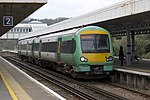 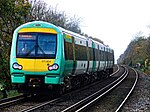
|
DMU | 100 | 160 | 12[78][79] | 3 | Brighton Main Line (London Bridge to South Croydon) Oxted line (to Uckfield only) East Coastway line Marshlink line |
2003–04 |
| 4[79] | 2 | ||||||||
| Bombardier Electrostar | 377/1 |  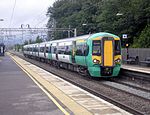 
|
EMU | 64 | 4 | Entire Southern network apart from sections between Hurst Green and Uckfield & between Ore and Ashford International | 2001–05 | ||
| 377/2 | 15 | ||||||||
| 377/3 | 28 | 3 | |||||||
| 377/4 | 75 | 4 | |||||||
| 377/6 | 26 | 5 | |||||||
| 377/7 | 8 | ||||||||
| 387/2 | 
|
110 | 177 | Varies | 4[80] | Units borrowed from Gatwick Express on a rotational basis according to demand. Brighton Main Line |
2016–17 | ||
Past fleet
[edit]Former units operated by Southern include:
| Class | Image | Type | Built | Left fleet |
Notes |
|---|---|---|---|---|---|
| 205 (3H) | 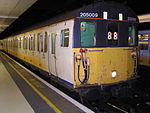
|
DMU | 1957–62 | 2004 | Replaced by Class 171 Turbostar |
| 207 (3D) | 
|
1962 | |||
| 313 | 
|
EMU | 1976–77 | 2023[81] | Replaced by Class 377 Electrostar |
| 319 | 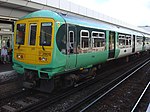
|
1987 | 2008 | Replaced by Class 377 Electrostar | |
| 350/1 Desiro | 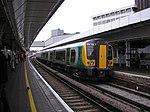
|
2004–05 | 2009 | Subleased from London Midland in 2008 to provide cover for Class 377 Electrostar units subleased to First Capital Connect. After newer Class 377 Electrostar trains were built, these units were returned to London Midland. Replaced by newer Class 377 Electrostar units.[63] | |
| 421 (4CIG) | 
|
1964–66 | 2005 | Replaced by Class 377 Electrostar | |
| 423 (4VEP) | 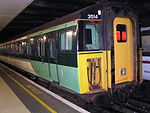
|
1967–71 | |||
| 455 | 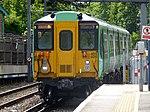
|
1982–84 | 2022 | ||
| 456 | 
|
1990–91 | 2014 | Replaced by Class 377/6 Electrostar | |
Depots
[edit]Southern's fleet is maintained at Brighton Lovers Walk and Selhurst depots. The Gatwick Express fleet is maintained at Stewarts Lane.
Light maintenance is also carried out at Littlehampton for the electric fleet, and St Leonards for the class 171 fleet when on Marshlink services.
Future
[edit]Southern, as part of its successful bid for the South Central franchise in 2009, made several commitments to improving services across the network.[25] These included:
- Increasing the length of suburban services in South London to 10 cars between 2011 and 2013
- Increasing the service level on all routes in South London to 4 trains per hour (tph) until 23:00 each day, and the introduction of late-night services on Fridays and Saturdays
- The introduction of an hourly service on Sundays between Brighton and Southampton Central, and an increase in the number of late-night services between Brighton and Worthing
- The introduction of late-night services on the London to Uckfield route
- Installation of new ticket gates at 22 stations across the network
- Increasing the number of car-parking spaces at stations by 1,000 and the number of cycle spaces by 1,500
- Cleaning and refreshing of all stations and trains on the network
- Major refurbishments to seven stations: Brighton, Haywards Heath, Hove, Lewes, Redhill, Three Bridges and Worthing
Uckfield–Lewes line
[edit]The franchise consultation paper released at the beginning of the 2009 franchising process stated that the ultimate franchise agreement would include a change mechanism to enable the DfT to incorporate additional routes into the South Central franchise, and it invited bidders to submit priced options for schemes put forward by stakeholders. One such scheme could, as indicated in the South Central Franchise Consultation Paper, be the reopening of the Uckfield – Lewes line, closed in 1969.[82] During the 2010s, several interested parties have been examining the possibility of reopening the line.[83][84]
Future of the franchise
[edit]In January 2016, Transport for London announced a proposal to take over the London suburban parts of the franchise in 2021 through a partnership with the Department for Transport to form a new suburban metro service.[85] However, the plan was rejected by Transport Secretary Chris Grayling in December 2016.[86]
In January 2017, it was reported that the Department for Transport was considering temporarily renationalising the franchise if the service did not improve.[87]
On 17 June 2021, the DfT extended the current contract from 19 September 2021 to 31 March 2022.[88]
The contract for the delivery of Thameslink, Southern and Great Northern services was extended by the DfT on 25 March 2022. The current contract will now expire on 1 April 2028.[1]
Rolling out of smartcards
[edit]This section needs to be updated. (July 2016) |
Southern was criticised in January 2007 for not wishing to introduce Oyster Pay As You Go on its London routes, stating that it was not financially viable. In 2007, Southern introduced Oyster on its Watford Junction to Clapham Junction route,[89] and the company later agreed in principle to the introduction of Oyster across its network,[90] but did not give any firm timescale, managing director Chris Burchell saying
"There are still a number of outstanding issues that need to be discussed with TfL, but we do not believe these will prevent us making PAYG a reality on our network. We look forward to discussions with TfL on how we can make this happen as soon as possible for our passengers."[91]
In its successful franchise bid in 2009, Southern said it was committed to rolling out Oyster Pay As You Go in the London area, but also that such a move was subject to industry agreement.[25] Since 2 January 2010, Oyster Pay As You Go has been valid on all its London routes, along with most other train services in the London area. In addition, Oyster is valid on Southern services beyond the Greater London boundary as far as Epsom, Epsom Downs, Tattenham Corner, Upper Warlingham, Caterham and Gatwick Airport.[citation needed]
The Key
[edit]In 2012, Southern became the first rail company in England to use the ITSO card on its network. The Key is a smartcard similar to Transport for London's Oyster card. Tickets of various types can be purchased for the smartcard at ticket vending machines across the majority of the GTR network, except within Oyster-capable travel areas, as well as online (season tickets only).
Three forms of Key exist: child, adult, and staff. All child smartcards need a photograph, which is printed onto the card, as well as proof of age while registering. The Key can be de-activated and the tickets transferred to a new card sent out in the post if the smartcard is reported as lost, stolen or faulty.[92] Staff smartcards are only issued to employees of GTR, and offer unlimited travel across all of GTR's network.[citation needed]
The Key also has a pay-as-you-go feature called keyGo. With this, customers can tap in and out freely within the keyGo area, and the cheapest combination of tickets from the entire day's taps are automatically calculated at the end of the railway day and automatically charged to a linked payment card. keyGo is also valid on Brighton & Hove buses and Metrobus services within certain areas. Bus journeys are charged at the single, day zonal, day network or Plusbus rates as appropriate.[93]
The Key can be used on all National Rail services where tickets are available for purchase on smartcards.[92]
See also
[edit]Notes
[edit]References
[edit]- ^ a b "National Rail Contract Thameslink, Southern and Great Northern" (PDF). Department for Transport. 24 March 2022. Retrieved 7 March 2023.
- ^ "Southern Railway Limited: company no 6574965". Companies House. Archived from the original on 13 April 2016.
- ^ "Southern Rail voted UK's worst train service for third year in a row". The Independent. 16 January 2018. Archived from the original on 30 November 2020. Retrieved 13 January 2019.
- ^ "Passengers rank 'worst' rail companies as Southern named among least punctual". ITV News. 9 February 2022. Retrieved 20 November 2022.
- ^ "South Central rail franchise Due this Month" (Press release). Shadow Strategic Rail Authority. 10 October 2000. Archived from the original on 3 November 2013. Retrieved 27 September 2012.
- ^ "Six Companies Shortlisted for First Franchise Replacement Round" (Press release). Shadow Strategic Rail Authority. 14 March 2000. Archived from the original on 16 October 2013. Retrieved 9 November 2012.
- ^ a b "Connex loses rail franchise". BBC News. 24 October 2000. Archived from the original on 25 February 2009. Retrieved 11 June 2009.
- ^ "Proposed acquisition by Govia Limited of Connex South Central Limited". Office of Fair Trading. 16 August 2001. Archived from the original on 29 May 2012.
- ^ "Completion of Acquisition of South Central Franchise" (Press release). Go-Ahead. 28 August 2001. Archived from the original on 21 October 2001.
- ^ "Annual Accounts 2001" (PDF). Go-Ahead Group. 30 June 2001. Archived from the original (PDF) on 23 November 2012.
- ^ "New Southern Railway Limited formerly South Central Limited: company no 3010919". Companies House. Archived from the original on 13 August 2016.
- ^ Haigh, Philip (18 September 2002). "SRA slashes South Central franchise from 20 to seven years". RAIL. No. 444. pp. 6–7.
- ^ "New franchise agreement for South Central". Entrain. No. 19. Sheffield. July 2003. p. 6.
- ^ "(DFT) Agreement signed to amend Gatwick Express and Southern franchises". whitehallpages.net. Archived from the original on 2 November 2013.
- ^ "Agreement to amend the Gatwick Express and Southern Franchises" (Press release). Go-Ahead. 19 June 2007. Archived from the original on 23 November 2012.
- ^ "Gatwick service benefits Brighton". BBC News. 14 December 2008. Archived from the original on 19 February 2009. Retrieved 11 October 2009.
- ^ "December 2008 timetable change". Southeastern News. 4 December 2008. Archived from the original on 4 November 2013.
- ^ "Agreement signed to amend Gatwick Express and Southern franchises". Department for Transport. 19 June 2007. Archived from the original on 18 July 2007.
- ^ "Next stop South London". The Londoner. Greater London Authority. 8 March 2008. Archived from the original on 22 January 2009.
- ^ "UK govt mulling handover of part of Go-Ahead's Southern franchise to TfL". Forbes. New York. 10 March 2008. Retrieved 11 June 2009.[dead link]
- ^ "Bidders for South Central franchise announced" (Press release). Department for Transport. 20 August 2008. Archived from the original on 2 November 2013.
- ^ "Bidders for South Central franchise announced" (Press release). Department for Transport. 20 August 2008. Archived from the original on 24 February 2012. Retrieved 17 June 2009.
- ^ "Nat Exp and Stagecoach on rail bid shortlist". Reuters. 20 August 2008. Archived from the original on 30 November 2020. Retrieved 11 June 2009.
- ^ "Retention of South Central franchise" (Press release). Go-Ahead. 9 June 2009. Archived from the original on 24 October 2011.
- ^ a b c "More frequent and more secure rail services for London and the South East" (Press release). Department for Transport. 9 June 2009. Archived from the original on 19 June 2009. Retrieved 17 June 2009.
- ^ "Thameslink Franchise OJEU Notice" (PDF). Department for Transport. 19 December 2011. Archived from the original (PDF) on 27 May 2013. Retrieved 28 December 2011.
- ^ "Bidders to oversee improvements on rail franchises announced" (Press release). Department for Transport. 29 March 2012. Archived from the original on 8 November 2012. Retrieved 27 September 2012.
- ^ "West Coast Main Line franchise competition cancelled" (Press release). Department for Transport. 3 October 2012. Archived from the original on 10 October 2012. Retrieved 17 October 2012.
- ^ "Official Journal of the European Union Notice" (PDF). Department for Transport. 19 December 2011. Archived from the original (PDF) on 27 May 2013.
- ^ "Consultation on the Combined Thameslink, Southern and Great Northern franchise" (PDF). Department for Transport. May 2012. Archived from the original (PDF) on 17 June 2012.
- ^ "Thameslink, Southern and Great Northern franchise". Go-Ahead Group. Archived from the original on 20 March 2015.
- ^ "Rail revolt as trains dump passengers". West Sussex County Times. Horsham. 20 January 2009. Archived from the original on 18 January 2010. Retrieved 4 February 2009.
- ^ "Commuters form pressure group". Eastbourne Herald. 8 January 2009. Retrieved 26 January 2009.
- ^ "Record of Meetings". Southern East Coastway Commuters. 24 January 2009. Archived from the original on 7 November 2012. Retrieved 26 January 2009.
- ^ "News Christmas 2008". Bexhill Rail Action Group. Archived from the original on 5 September 2011. Retrieved 26 January 2009.
- ^ "News – Southern Railway". Southern. 22 January 2009. Retrieved 26 January 2009.[dead link]
- ^ "BRAG's Faster Trains Campaign". Bexhill Rail Action Group. January 2009. Archived from the original on 5 September 2011. Retrieved 26 January 2009.
- ^ "Rail users want faster trains". Eastbourne Herald. 22 January 2009. Archived from the original on 29 January 2009. Retrieved 26 January 2009.
- ^ a b "December timetable changes announced : Southern". Archived from the original on 31 December 2016. Retrieved 30 December 2016.
- ^ "Britain's worst train service: Southern's 7.29 Brighton to London train was late every day for a year". The Daily Telegraph. London. 12 January 2015. Archived from the original on 30 August 2016. Retrieved 23 May 2023.
- ^ "Southern Railway fines passengers forced to stand in first class". The Daily Telegraph. London. 19 May 2015. Archived from the original on 7 March 2016. Retrieved 4 April 2018.
- ^ Watts, Joseph (17 June 2016). "Govia Thameslink Railway boss refuses to defend CEO £2m pay". Evening Standard. London. Archived from the original on 30 November 2020. Retrieved 20 June 2016.
- ^ Craig Richard (17 June 2016). "Boss of Epsom's main train operator Govia Thameslink Railway takes home £2.1m paycheck despite "appalling service"". Your Local Guardian. Archived from the original on 18 June 2016. Retrieved 20 June 2016.
- ^ "MPs urge ministers to 'get a grip' in midst of Southern strike woes". BBC News. 14 October 2016. Archived from the original on 17 October 2016. Retrieved 28 December 2016.
- ^ "Rail strike: MPs tell government to 'get a grip' on franchises". The Week UK. 14 September 2016. Archived from the original on 29 December 2016. Retrieved 28 December 2016.
- ^ a b "Southern rail timetable 'loses 350 trains a day'". BBC News. 4 July 2016. Archived from the original on 4 July 2016. Retrieved 4 July 2016.
- ^ "Southern rail suggests commuter goes 100 mile detour to Clapham instead of her normal six minute journey". Evening Standard. London. 15 June 2016. Archived from the original on 3 July 2017. Retrieved 4 April 2018.
- ^ "Thameslink woes hit Go-Ahead shares". BBC News. 14 June 2016. Archived from the original on 17 June 2016. Retrieved 20 June 2016.
- ^ "Southern restores more services to the timetable". Southern Railway. 20 October 2016. Archived from the original on 28 October 2016. Retrieved 28 October 2016.
- ^ "RSSB: "No evidence of increased risk" from DOO". Rail Magazine. Archived from the original on 20 December 2016. Retrieved 17 December 2016.
- ^ "Southern rail and unions to hold new talks over strikes". BBC News. 13 December 2016. Archived from the original on 27 March 2018. Retrieved 21 June 2018.
- ^ "Southern railway pre-Christmas strike dates changed". BBC News. 1 December 2016. Archived from the original on 30 November 2017. Retrieved 21 June 2018.
- ^ "The politics behind the Southern rail dispute". BBC News. 13 December 2016. Archived from the original on 27 March 2018. Retrieved 21 June 2018.
- ^ Swinford, Steven (13 December 2016). "Taxpayers foot £50m bill for Southern rail strike chaos as ministers prepare to tighten law". The Telegraph. Archived from the original on 28 December 2016. Retrieved 23 May 2023.
- ^ "Why Southern Rail's Strikes May Go on For Years". Archived from the original on 4 January 2017. Retrieved 3 January 2017.
- ^ "The Southern Rail mess isn't a privatisation failure – it's a return to the 1970s". citymetric.com. 8 August 2016. Archived from the original on 4 January 2017. Retrieved 3 January 2017.
- ^ "Statement on the successful resolution to talks between GTR (Southern Rail) and ASLEF". Archived from the original on 3 February 2017. Retrieved 2 February 2017.
- ^ "Southern June 2024 Timetable".
- ^ Haigh, Philip (20 March 2002). "South Central orders 460 Electrostar coaches for £657M". RAIL. No. 431. pp. 4–5.
- ^ Roden, Andrew (21 August 2002). "In the Strategic Plan, but now the SRA drops South Central electrification…". RAIL. No. 442. pp. 4–5.
- ^ "Extra 170 for Southern". Today's Railways UK. No. 62. February 2007. p. 63.
- ^ "DMU digest". Today's Railways UK. No. 69. September 2007. p. 62.
- ^ a b "Desiros for Loan to Southern". Southern Electric Group. Archived from the original on 28 September 2013. Retrieved 28 September 2009.
- ^ "Class 460s bow out". Today's Railways UK. No. 131. November 2012. p. 67.
- ^ "Class 313s come to Southern". Southern Electric Group. Archived from the original on 20 August 2013.
- ^ "Southern takes on 313/1 from LOROL". RAIL. No. 629. 21 October 2009. p. 32.
- ^ Clinnick, Richard (2 June 2010). "Southern starts £6 million refresh of 20 Class 313s". RAIL. No. 645. pp. 26–27.
- ^ "Southern Class 313s to be withdrawn from traffic in May". Railways Illustrated. No. 244. 4 May 2023. p. 19.
- ^ "Southern to order more trains as Thameslink slips". Railnews. 19 September 2011. Archived from the original on 27 November 2011. Retrieved 15 November 2011.
- ^ "Bombardier Wins Additional Order for 130 Electrostar Cars from Southern in the UK" (Press release). Bombardier. 28 December 2011. Archived from the original on 2 November 2013. Retrieved 28 December 2011.
- ^ "DfT acts to ease Thameslink trains logjam". Railnews. 16 November 2012. Archived from the original on 18 November 2012.
- ^ "Engineering plans at Haymarket Depot" (PDF). Abellio ScotRail. Archived from the original (PDF) on 22 August 2016.
- ^ "Scottish Class 170/4s move south after transfer to Southern". Rail Magazine. No. 772. 15 April 2015. p. 12.
- ^ "GTR readies former ScotRail Class 170/4s". Rail Magazine. No. 804. 6 July 2016. p. 30.
- ^ "👋 Today we're saying goodbye to our Class 455s. After 40 years in service, the farewell tour will take place on The Metro Marauder route and features two Class 455/8s. All profits will be donated to good causes nominated by GTR". Twitter. @SouthernRailUK. 14 May 2022. Archived from the original on 14 May 2022. Retrieved 16 May 2022.
- ^ "Units numbers 377 163 and 377 164 transfer from Southeastern to Southern exact dates. - a Freedom of Information request to SE Trains Limited". WhatDoTheyKnow. 13 December 2022. Retrieved 21 July 2023.
- ^ "EMR EVOLVES FOR THE FUTURE". Modern Railways. No. 889. August 2022. pp. 51–56.
- ^ "EMR EVOLVES FOR THE FUTURE". Modern Railways, October 2022 page 52.
- ^ a b Southern Useful Information Archived 6 September 2013 at the Wayback Machine - Southern. Retrieved 29 August 2013.
- ^ "Units". Rail Express. No. 318. November 2022. p. 27.
- ^ Southern Railway [@SouthernRailUK] (19 May 2023). "The last day of scheduled passenger services with 313 stock was today" (Tweet). Retrieved 23 May 2023 – via Twitter.
- ^ "South Central Franchise Consultation Paper" (PDF). Department for Transport. 22 May 2008. Archived from the original (PDF) on 4 November 2013. Retrieved 21 August 2008.
- ^ "Lewes-Uckfield rail line: re-instatement study under way" (Press release). East Sussex County Council. 3 January 2008. Archived from the original on 20 November 2008. Retrieved 11 June 2009.
- ^ "Green signal to reopen rail line". The Argus. Brighton. 21 June 2006. Archived from the original on 2 November 2013. Retrieved 7 July 2013.
- ^ "TfL to control all London commuter services and new metro network". Archived from the original on 28 January 2016. Retrieved 21 January 2016.
- ^ Gillett, Francesca (7 December 2016). "Sadiq Khan hits back after government blocks suburban rail takeover plan". Evening Standard. London. Archived from the original on 17 August 2017. Retrieved 29 June 2017.
- ^ Swinford, Steven (26 January 2017). "Southern rail could be temporarily renationalised to deal with 'appalling' delays and cancellations". The Telegraph. Archived from the original on 19 July 2017. Retrieved 23 May 2023.
- ^ "GTR contract extended to March 2022". The Go-Ahead Group. Retrieved 28 June 2021.
- ^ "Oyster card". Southern. Archived from the original on 9 June 2011. Retrieved 11 October 2009.
- ^ "Oyster cards for ALL trains". Evening Standard. London. 31 January 2007. Archived from the original on 26 August 2016. Retrieved 4 April 2018.
- ^ "Southern say yes to Oyster". Wimbledon Gazette. 3 February 2007. Archived from the original on 28 February 2008. Retrieved 11 June 2009.
- ^ a b "The key smartcard | Southern Railway". southernrailway.com. Retrieved 3 May 2023.
- ^ "KeyGo | Southern Railway". southernrailway.com. Retrieved 3 May 2023.
External links
[edit] Media related to Southern (train operating company) at Wikimedia Commons
Media related to Southern (train operating company) at Wikimedia Commons- Official website

- Airport rail links in London
- Go-Ahead Group companies
- Keolis
- Railway companies established in 2001
- Railway operators in London
- Rail transport in East Sussex
- Rail transport in Hampshire
- Rail transport in Kent
- Rail transport in Surrey
- Rail transport in West Sussex
- Train operating companies in the United Kingdom
- 2001 establishments in England

